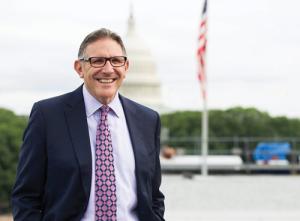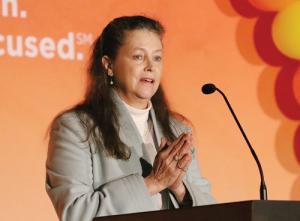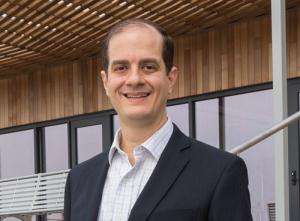Large Public Power Council
Jackie Sargent, GM at Austin Energy, is the new chair of the Large Public Power Council.
Tom Falcone, CEO of the Long Island Power Authority, is the new co-chair of the Large Public Power Council.
John Di Stasio is president of the Large Public Power Council.
The Large Public Power Council's members provide energy to about ten percent of the nation's population. That is huge, so PUF was paying attention when Jackie Sargent, General Manager of Austin Energy, and Tom Falcone, CEO of the Long Island Power Authority, recently were elected as the organization's chair and vice-chair, respectively.

PUF wanted to know what the new leadership has in mind for an organization comprised of twenty-seven of the nation's largest public power systems. After all, the industry is undergoing transformational change on all levels.
PUF sat down with the new chair and vice-chair to learn what the future holds. As a bonus, LPPC president, John Di Stasio, was there too.
PUF's Steve Mitnick: How did this get started?
John Di Stasio: The Large Public Power Council is an organization of twenty-seven of the largest public power systems in the U.S. plus Puerto Rico. We've been in existence since 1987.
 Jackie Sargent: We have a diverse membership and that’s key to the success of LPPC. What has kept it strong over the years is it’s a CEO-driven organization. When we have meetings, the CEOs are the board members. They’re at the table.
Jackie Sargent: We have a diverse membership and that’s key to the success of LPPC. What has kept it strong over the years is it’s a CEO-driven organization. When we have meetings, the CEOs are the board members. They’re at the table.
Collectively, our members serve about thirty million electric consumers. What differentiates us, is that we're all part of the overall public power community, but the larger asset-owning systems that comprise the LPPC have unique sets of challenges and opportunities.
Like our entire industry, public power is moving toward a cleaner resource mix and our members are focused on decarbonization and the pathways to get there, like electrification.
But what's still front and center is reliability and resilience because as you're in transition, the world's changing, and planning and operations are different than they've historically been. We also have a changing demographic in the workforce coming out of the pandemic.
PUF: Jackie, you're going to chair LPPC, and you're known as an innovator. You're in Texas, so there're special challenges. What does this mean for you at LPPC?
 Tom Falcone: I’ve borrowed good ideas from other leaders. We’re in the process, for example, of moving to time-of-use rates for all our customers. That’s something we borrowed from SMUD, and our governance structure came from another LPPC member.
Tom Falcone: I’ve borrowed good ideas from other leaders. We’re in the process, for example, of moving to time-of-use rates for all our customers. That’s something we borrowed from SMUD, and our governance structure came from another LPPC member.
Jackie Sargent: We have a diverse membership and that's key to the success of LPPC. What has kept it strong over the years is it's a CEO-driven organization. When we have meetings, the CEOs are the board members. They're at the table.
It's important we continue to keep this an organization where we share best practices. We take away what has worked well for our utilities, and we learn from what hasn't.
We are all facing similar issues, such as supply chain disruptions, cybersecurity, working toward decarbonization, and ensuring we have reliable and resilient systems that are there for all our customers.
I want to prioritize how LPPC can help. We have a strategic plan and we're preparing for a meeting in May to do a refresh.
We've got a mission, a vision, and several goals. A lot of things have changed since 2019. Is that the right path forward? Does that still make sense? Then, how do we best advocate for those priorities in Washington?
At the same time, we've learned to be flexible and adaptive because when you look at the pandemic and what that meant for changing our operational position but continuing to reliably meet the needs of our customers, it's amazing. We kept our employees safe, and we continued to provide safe, reliable, and affordable energy to our consumers.
PUF: Tom, you're leading the Long Island Power Authority. You've decided to take on a leadership role at LPPC, so what does that mean for you and LIPA?
Tom Falcone: The LPPC and public power are special. It is a great business model because it's local control, it's what our consumers want, and there's direct consumer impact. Public power is a low-cost model — we have financing advantages and federal grant eligibility that lowers costs to our customers.
Serving in LPPC leadership is a chance to give back to public power and to LPPC, because LPPC has given LIPA a lot of good ideas, and there's community, getting around the table, meeting with fellow CEOs. I've borrowed good ideas from other leaders.
We're in the process, for example, of moving to time-of-use rates for all our customers. That's something we borrowed from SMUD, and our governance structure came from another LPPC member.
PUF: Now, that you're putting together a strategic plan for LPPC. What comes to mind?
Jackie Sargent: The strategic plan we did in 2019 was well thought out. We're looking at those things and saying, they seem to still fit today, but we want to bring that in front of membership and make sure those are still the mission and vision that meet the needs of the organization and membership.
Because we have such a good foundation, this is more of a strategic plan refresh, as opposed to a strategic plan rewrite.
What it will do is define some high-level goals to give direction to John and the team at LPPC, and they'll come back with actionable items, like they did after the 2019 plan. We're going to hear about the status of those action items.
One item was creating a strong presence in Washington D.C., which John did by coming to our board and moving to D.C. We want to prioritize our policies regarding tax and finance, infrastructure, resiliency, environmental policy, changing customer expectations, reliability, and support for our customers and workers.
PUF: Tom, talk about that aspect of federal versus state, and how that's important to your members.
Tom Falcone: There's a dramatic transition that's ongoing in the electric utility industry. There are two ways that LPPC members help each other. First, we share what each of us are doing. We're all moving toward cleaner sources of energy, for example.
We're all looking at opportunities for electric vehicles and beneficial electrification. We're all looking for reliability, resiliency, and cost-effective transmission. We're focused on cybersecurity.
The first thing is, what are each of us doing, how are we getting there, and what can we learn from each other? The second is where it interacts with John's role in D.C., and on every one of those issues, there's a federal role.
For clean energy, it's tax credits on renewables and we're focused on making sure there are lots of tax credits — they fund about a third of the cost of renewables — and that our non-profit members have equal access as taxable utilities.
There's the new federal Infrastructure and Jobs Act, and that has pockets of money for reliability, resiliency, clean energy, hydrogen hubs, and storage. How can we all work together as LPPC members and work in D.C., to move forward with those key initiatives?
It doesn't matter what initiative we have, even though we represent diverse constituencies, with different priorities and energy. There is a lot in common.
John Di Stasio: With so much of our industry being monopolies, and in some cases state-regulated monopolies, a lot of what we've responded to over the years has come to us through legislation and regulation.
I'd argue now there are a lot of emerging trends that are not necessarily coming at us through those channels, but coming from consumers, technologies, or new business models.
Part of what we're trying to do is be effective on what's in front of us, but also with an eye on the horizon and ask, what are externalities we need to pay attention to, discuss, adapt, and position ourselves for? We're at the point at which there is going to be legislation and we're informing that.
PUF: How is large public power doing these days and how does the future look?
Jackie Sargent: The future for large public power looks bright, and we have a lot going on across all our utilities. When we look at some of those in terms of advancing technologies, decarbonization, renewables, energy efficiency programs, reducing customer consumption, and electrification, we see electrification is going to play a significant role.
Electric vehicles are at ten percent of all new vehicle registrations in Austin, and we're continuing to see growth and adoption of that technology. Electric vehicle manufacturers show interest in Austin and surrounding areas. We have a high-tech sector in Austin too, and people are engaged and interested in energy.
Austin is one of the fastest growing cities in the nation, and we need technologies to meet that growth and expectations of customers, while managing reliability and affordability. Public power has been able to offer our customers affordable rates while testing out new technologies, doing pilot programs, being able to bring solutions to the table that maybe aren't as feasible in other areas, and that's of value.
PUF: For public power in New York State and LIPA, how's your future looking?
Tom Falcone: We have aggressive clean-energy goals in New York. We have to get to a carbon-free electric grid by 2040. We're in the middle of planning for that. We have about thirty-four hundred megawatts of new clean resources that are going to hit the Long Island grid between now and 2030.
That includes offshore wind, storage, and solar. We're planning for a grid transition, but we're also focused on reliability and resiliency.
We have aggressive resiliency plans because we're an island, so climate and weather affect us. We get decent sized storms — winter storms and hurricanes. We want resilient, clean, and reliable energy, but we have to do it affordably. Public power has two great advantages.
One is lower cost of capital and access to federal funds. We've gotten nearly two billion dollars of federal funds from the Federal Emergency Management Agency to cover the cost of storms, hurricanes, and resiliency investments over the last ten years.
We're looking at federal grant programs and other ways to access innovation — whether that's hydrogen hubs, storage, resiliency, or transmission. We have to build more transmission on Long Island, because we're having all this offshore wind landing here, and we're at the tail end of the electric grid and have to get it to the rest of the state.
Number two, we're meeting our customers' needs as we're not for profit. We want to be in the top ten percent of utilities for reliability, have a zero-carbon grid, want building electrification, and resiliency. These are all driven by our board, and by our customers.
John Di Stasio: The third value of public power is because you don't have to go through a state regulatory process, our speed to a decision and implementation can be a lot faster. We benefit from being nimble, which gives us the ability to quickly address what's in the interest of our consumers. That helps move the needle on a lot of these emerging techs.
Jackie Sargent: Customers don't compare us to other utility providers. They're comparing us to other services.
I use the example of Domino's Pizza. I order my pizza on the app, can see when they put it in the oven, take it out, and it's in the driver's vehicle. The pizza gets delivered to me, and expectations have been managed.
We have smarter meters that give data at the customer's premise, we have an outage management system, and an automated distribution management system. We can take all that data, bring it back, and utilize tools that give an outage map. When customers experience an outage, they can look at the app and see the estimated time of restoration.
PUF: Where do you think LIPA and the Large Public Power Council utilities are going to be, say, three to five years out?
Tom Falcone: The industry is changing. We're investing a lot in IT, customer service, reliability, resiliency, and clean energy. It's a time of rapid change in our customer's expectations. When we look three to five years out, you don't make great leaps in a minute, but you're going to see steady progress across all those fronts.
In the State of New York, we get about twenty percent of our energy needs from electricity and with the state's aggressive climate goals, it's going to be about seventy percent from electricity. Electricity is becoming the clean-energy source of this century. We're already central to providing electric for your phone, transportation, heating, for everything you're doing.
What you're going to see three to five years from now, is good progress across electric vehicle deployment, and clean energy. We're going to see change, and our customers will see the benefit.
Jackie Sargent: We are going to see breakthroughs in technology on the storage side that are going to help us with this transition to a clean energy economy. As we continue to get data and translate that into information to better serve our customers, we're going to see an increased focus on cybersecurity.
COVID taught us we can work differently. Work is what you do, not necessarily where you do it.
As we transition to a more hybrid workplace environment and we're faced with the challenges of ensuring people have tools to thrive, we're going to figure out better ways to address diversity, equity, and inclusion. That's going to translate into better delivery of programs.
Lead image: John Di Stasio.



